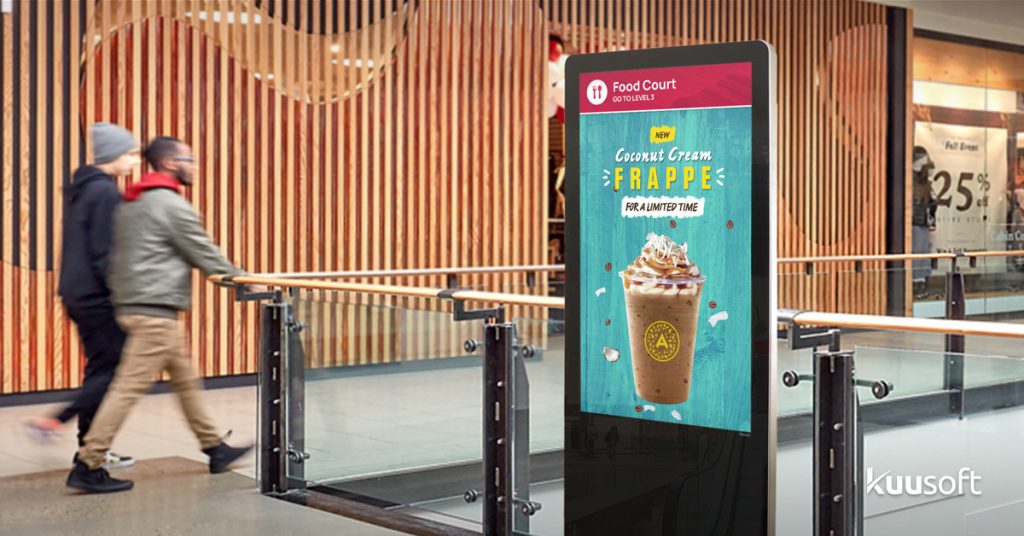
Out-of-home (OOH) advertising has become part of everyday life in modern society. We see ads everywhere we look, whether on the street, commuting to work, at the office, or enjoying an event. And the reason ads are always there is…. it’s proven to work! Research confirms that over 65% of consumers made a direct purchase because a sign caught their eye.
In this blog post, we’re covering digital out-of-home (DOOH) advertising. You’ll learn what this term means, along with various types of DOOH, how it evolved, and ways to use it with digital signage software.
What is DOOH Digital Signage?
Digital out-of-home advertising is a marketing channel that uses digital signage to deliver ads in public spaces. It has 3 fundamental aspects:
- Use a digital display
- Placed in a public area like a stadium, mall, or subway station
- Use advertising technology for geolocation, personalization, and metric tracking
Supermarkets, grocers, convenience stores.
Digitalization is the main difference between traditional outdoor ads and DOOH. Traditional outdoor ads include static billboards, posters, and signs. Using technology allows marketers to curate campaigns that maximize the ad inventory space and personalize the message.
3 Benefits of DOOH Advertising
The combination of OOH and digital marketing presents many benefits to advertisers. Here are some of the reasons you should consider investing in DOOH.

1. Dynamic
Creative assets can be changed depending on the time of day, location, and audience.
Let’s say you want to advertise your restaurant at a train station. With DOOH advertising, like a kiosk, you can show your breakfast menu to morning commuters. Later in the day, you can adjust the ad with lunch or dinner items.
2. Interactive
Touchscreen displays, 3D billboards, games, and tutorials create personal experiences for ad-viewers. Over the years, innovative advertising methods have become more digitalized – for example the Drinkable Poster.
3. Pervasive
Advertising is about capturing attention. Online ads, pre-roll ads, and even TV commercials are easy to avoid. Consumers can change the channel, hit mute, or install an ad blocker. This all stops the advertiser from reaching a key audience. On the other hand, ads in public spaces, especially creative or captivating ones, are much harder to avoid.
3 Types of Displays for DOOH Advertising
Typically, DOOH advertising is outdoors. But it can also be inside office buildings, shopping malls, sporting stadiums, and transit stations. Below are different forms of out-of-home display opportunities to consider for your business.
1. Large Format
The most famous example is the massive billboards in Times Square in New York City. Large-format digital displays are becoming more common in high-traffic areas. Even ad spaces beside freeways are becoming digitalized to deliver eye-catching ads and information. For Example:
- Billboards
- Public street furniture
- Transit station kiosks
2. Point-of-Sale (POS)
Another place where you can find DOOH digital signage is in retail. Digital screens placed on shelves or close to Point-of-Sale (POS) machines drive sales and boost brand awareness. They directly cater to already-incentivized customers to encourage impulse purchases. For Example:
- Convenient stores
- Grocery stores
- Pharmacies
- Delis
- Shopping malls

3. Location-Based
And finally, the last type of DOOH is known as location-based advertising. The goal of this form of advertising is to generate impressions where people spend a significant amount of time.
One of the most common locations-based DOOH is in office buildings. For example, it is a great place to use DOOH to promote a nearby restaurant to employees and visitors. Also, outdoor kiosks with information like company messaging, news, weather, or social media feeds are useful. For Example:
- College campuses
- Movie theaters
- Gyms
- Hotels
- Bars and restaurants
Evolution of DOOH Digital Signage
Digital displays have played a massive role in OOH advertising. Until recently, advertisers couldn’t capitalize on the advantages of digitalizing outdoor displays. Now that the cost of screens has fallen and there are various ways to leverage digital signage technology, the industry has exploded.
In 2020, DOOH was estimated to have a market cap of around $40 billion. By 2026, experts believe it will exceed $50 billion. Marketers can leverage the power of digital displays to deliver their message through interactivity and creativity.
Cloud Software
Another way technology has influenced DOOH is cloud-based software and IoT implementation.
Access to 5G and digital signage software has made DOOH advertising one of the highest-returning forms of marketing. Cloud software helps customize creative assets, like menus, based on dayparting, analytics, and locations.
You can take advantage of this technology with the Nano-PC. This solution is among the most cost-effective and easy-to-use forms of DOOH digital signage software.
You can learn more about NexSigns’ Digital Signage solution and connect with us on Facebook, LinkedIn, Twitter, and YouTube to get the latest info on digital signage!






3 comments
Comments are closed.